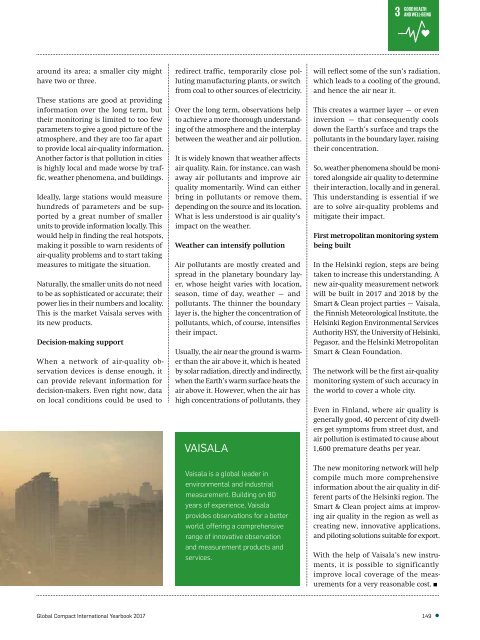Global Compact International Yearbook 2017
Sustainability in Troubled Times We life in times of uncertainty and global (dis)Order. „Understanding global mega-trends is crucial. We live in times of multiple, evolving and mutually-reinforcing shifts“, says UN Secretary-General António Guterres. He adds: „These dynamics, of geopolitical, demographic, climatic, technological, social and economic nature, enhance threats and opportunities on an unprecedented scale.“ Therefore sustainability in troubled times is the key topic of the Global Compact International Yearbook 2017, edited by macondo publishing.
Sustainability in Troubled Times
We life in times of uncertainty and global (dis)Order. „Understanding global mega-trends is crucial. We live in times of multiple, evolving and mutually-reinforcing shifts“, says UN Secretary-General António Guterres. He adds: „These dynamics, of geopolitical, demographic, climatic, technological, social and economic nature, enhance threats and opportunities on an unprecedented scale.“ Therefore
sustainability in troubled times is the key topic of the Global Compact International Yearbook 2017, edited by macondo publishing.
Create successful ePaper yourself
Turn your PDF publications into a flip-book with our unique Google optimized e-Paper software.
around its area; a smaller city might<br />
have two or three.<br />
These stations are good at providing<br />
information over the long term, but<br />
their monitoring is limited to too few<br />
parameters to give a good picture of the<br />
atmosphere, and they are too far apart<br />
to provide local air-quality information.<br />
Another factor is that pollution in cities<br />
is highly local and made worse by traffic,<br />
weather phenomena, and buildings.<br />
Ideally, large stations would measure<br />
hundreds of parameters and be supported<br />
by a great number of smaller<br />
units to provide information locally. This<br />
would help in finding the real hotspots,<br />
making it possible to warn residents of<br />
air-quality problems and to start taking<br />
measures to mitigate the situation.<br />
Naturally, the smaller units do not need<br />
to be as sophisticated or accurate; their<br />
power lies in their numbers and locality.<br />
This is the market Vaisala serves with<br />
its new products.<br />
Decision-making support<br />
When a network of air-quality observation<br />
devices is dense enough, it<br />
can provide relevant information for<br />
decision-makers. Even right now, data<br />
on local conditions could be used to<br />
redirect traffic, temporarily close polluting<br />
manufacturing plants, or switch<br />
from coal to other sources of electricity.<br />
Over the long term, observations help<br />
to achieve a more thorough understanding<br />
of the atmosphere and the interplay<br />
between the weather and air pollution.<br />
It is widely known that weather affects<br />
air quality. Rain, for instance, can wash<br />
away air pollutants and improve air<br />
quality momentarily. Wind can either<br />
bring in pollutants or remove them,<br />
depending on the source and its location.<br />
What is less understood is air quality’s<br />
impact on the weather.<br />
Weather can intensify pollution<br />
Air pollutants are mostly created and<br />
spread in the planetary boundary layer,<br />
whose height varies with location,<br />
season, time of day, weather – and<br />
pollutants. The thinner the boundary<br />
layer is, the higher the concentration of<br />
pollutants, which, of course, intensifies<br />
their impact.<br />
Usually, the air near the ground is warmer<br />
than the air above it, which is heated<br />
by solar radiation, directly and indirectly,<br />
when the Earth’s warm surface heats the<br />
air above it. However, when the air has<br />
high concentrations of pollutants, they<br />
VAISALA<br />
Vaisala is a global leader in<br />
environmental and industrial<br />
measurement. Building on 80<br />
years of experience, Vaisala<br />
provides observations for a better<br />
world, offering a comprehensive<br />
range of innovative observation<br />
and measurement products and<br />
services.<br />
will reflect some of the sun’s radiation,<br />
which leads to a cooling of the ground,<br />
and hence the air near it.<br />
This creates a warmer layer – or even<br />
inversion – that consequently cools<br />
down the Earth’s surface and traps the<br />
pollutants in the boundary layer, raising<br />
their concentration.<br />
So, weather phenomena should be monitored<br />
alongside air quality to determine<br />
their interaction, locally and in general.<br />
This understanding is essential if we<br />
are to solve air-quality problems and<br />
mitigate their impact.<br />
First metropolitan monitoring system<br />
being built<br />
In the Helsinki region, steps are being<br />
taken to increase this understanding. A<br />
new air-quality measurement network<br />
will be built in <strong>2017</strong> and 2018 by the<br />
Smart & Clean project parties – Vaisala,<br />
the Finnish Meteorological Institute, the<br />
Helsinki Region Environmental Services<br />
Authority HSY, the University of Helsinki,<br />
Pegasor, and the Helsinki Metropolitan<br />
Smart & Clean Foundation.<br />
The network will be the first air-quality<br />
monitoring system of such accuracy in<br />
the world to cover a whole city.<br />
Even in Finland, where air quality is<br />
generally good, 40 percent of city dwellers<br />
get symptoms from street dust, and<br />
air pollution is estimated to cause about<br />
1,600 premature deaths per year.<br />
The new monitoring network will help<br />
compile much more comprehensive<br />
information about the air quality in different<br />
parts of the Helsinki region. The<br />
Smart & Clean project aims at improving<br />
air quality in the region as well as<br />
creating new, innovative applications,<br />
and piloting solutions suitable for export.<br />
With the help of Vaisala’s new instruments,<br />
it is possible to significantly<br />
improve local coverage of the measurements<br />
for a very reasonable cost.<br />
<strong>Global</strong> <strong>Compact</strong> <strong>International</strong> <strong>Yearbook</strong> <strong>2017</strong> 149

















